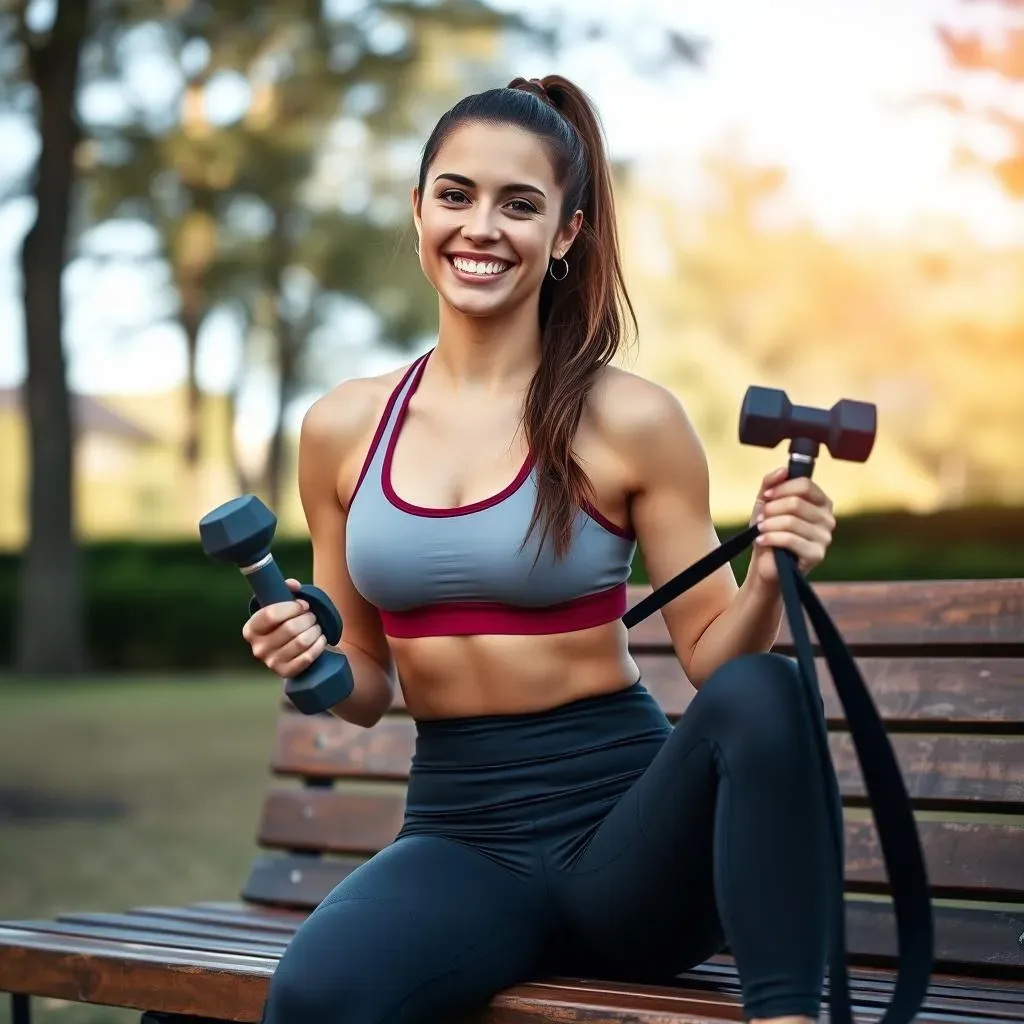Table of Contents
Are you a runner looking to boost your performance and prevent injuries? Then get ready to discover the secret weapon hiding right under your running shorts: your glutes! A strong, powerful butt isn't just aesthetically pleasing; it's crucial for runners. Strong glutes provide the power for your stride, improve stability, and significantly reduce your risk of common running injuries like runner's knee and shin splints. The good news? You don't need a fancy gym membership to achieve this. This article is your guide to the best butt workouts at home for runners – no equipment needed! We'll explore why strong glutes are essential for running, walk you through effective exercises you can do in the comfort of your own home, and help you build a sustainable routine that fits your lifestyle. Prepare to unleash your inner power and experience the transformative effects of targeted glute training on your running performance. Get ready to run stronger, faster, and injury-free!
Why Strong Glutes Matter for Runners

Why Strong Glutes Matter for Runners
Powerhouse of Your Stride
Think of your glutes – your gluteus maximus, medius, and minimus – as the powerhouse of your running stride. They're not just there for show; they're the primary muscles responsible for hip extension, the powerful backward movement that propels you forward with each step. Weak glutes mean less power in each stride, leading to a less efficient and potentially more tiring run. Imagine trying to jump really high with weak leg muscles – it's not going to happen!
Strong glutes are essential for generating the force needed for speed and endurance. They help maintain proper running form, preventing over-striding and other inefficient movements that can lead to injury. Runners often rely heavily on their quads and hamstrings, but ignoring the glutes is a recipe for muscle imbalances and potential problems down the road. It’s like trying to build a house on a weak foundation – it won’t last!
Muscle Group | Role in Running | Weakness Leads To |
|---|---|---|
Glutes (Maximus, Medius, Minimus) | Hip extension, power, stability | Inefficient stride, fatigue, injury risk |
Quads | Knee extension | Knee pain, muscle imbalances |
Hamstrings | Hip extension, knee flexion | Hamstring strains, muscle imbalances |
Injury Prevention and Stability
Beyond power, strong glutes are critical for injury prevention. They act as stabilizers, keeping your pelvis level and your legs aligned during your run. Weak glutes can lead to excessive knee and hip rotation, increasing your risk of runner's knee, IT band syndrome, and other common running injuries. Think of your glutes as the shock absorbers and stabilizers of your lower body, absorbing impact and maintaining balance.
Maintaining proper form is crucial for injury prevention, and strong glutes play a vital role in that. They help keep your posture upright and prevent excessive strain on other joints and muscles. By strengthening your glutes, you're not just improving your running performance, you're actively reducing your risk of injury. It's an investment in your long-term running health! It's like having strong support beams in a house; it adds stability and prevents collapse.
- Runner's Knee
- IT Band Syndrome
- Hip Pain
- Lower Back Pain
- Plantar Fasciitis
Effective Butt Workouts at Home for Runners: Exercises & HowTos

Effective Butt Workouts at Home for Runners: Exercises & HowTos
Bodyweight Bliss: Simple Exercises for a Stronger Butt
Let's ditch the gym equipment and embrace the power of bodyweight exercises! These are incredibly effective for building glute strength and are perfect for home workouts. We'll focus on exercises that specifically target the glutes, ensuring you get the most bang for your buck (or, should I say, your butt!). Remember to maintain proper form – focus on slow, controlled movements to really engage those muscles. Don't rush it; quality over quantity!
Here are a few of my go-to bodyweight exercises: Glute bridges (classic and effective!), donkey kicks (amazing for targeting the gluteus maximus), and fire hydrants (great for hip stability). You can find variations of these online, but the basic movements are simple enough to learn and master. Start with 2-3 sets of 10-15 repetitions for each exercise, gradually increasing the sets and reps as you get stronger. Listen to your body – if something feels off, stop and adjust!
- Glute Bridges: Lie on your back with knees bent, feet flat on the floor. Lift your hips off the ground, squeezing your glutes at the top. Lower slowly.
- Donkey Kicks: Start on your hands and knees. Lift one leg straight behind you, keeping your knee slightly bent. Squeeze your glutes at the top.
- Fire Hydrants: Start on your hands and knees. Lift one leg out to the side, keeping your knee bent at a 90-degree angle. Squeeze your glutes.
Adding Resistance: Level Up Your Glute Gains
Once you've mastered the bodyweight exercises, it's time to add some resistance! This will challenge your muscles further and help you build even more strength and definition. The simplest way to add resistance is by using resistance bands. These inexpensive bands provide a great way to intensify your workout, making even simple exercises more challenging. You can find them online or at most sporting goods stores.
Resistance bands can be used with many exercises, including glute bridges, squats, and lateral walks. Simply wrap the band around your thighs and perform your chosen exercise. The resistance will force your glutes to work harder, leading to faster results. Remember to choose a resistance level that's challenging but not impossible. It’s all about finding the sweet spot where you're pushing yourself, but not sacrificing good form. And don't forget to vary your resistance level to keep things interesting!
Exercise | Resistance Band Placement | Focus |
|---|---|---|
Glute Bridges | Around thighs, just above knees | Increased glute activation |
Squats | Around thighs, just above knees | Increased glute and quad activation |
Lateral Walks | Around ankles | Improved hip abduction and stability |
Building a Sustainable Butt Workout Routine for Runners

Building a Sustainable Butt Workout Routine for Runners
Consistency is Key: Making Glute Training a Habit
Building a strong butt isn't a sprint; it's a marathon! Consistency is the name of the game. Aim for at least 2-3 glute workouts per week, but don't feel pressured to overdo it, especially when starting. It's better to start slowly and gradually increase the intensity and frequency of your workouts. Remember, progress takes time, and listening to your body is crucial. Overtraining can lead to injuries and burnout, so be patient and celebrate your small victories along the way. Think of it like building a strong foundation – you lay the bricks steadily and consistently, and eventually, you have a solid structure.
Consider integrating your glute workouts into your existing running schedule. You could do a dedicated glute workout on your rest days or even incorporate some simple glute exercises as part of your warm-up or cool-down routine on running days. Flexibility is key! Find what works best for your schedule and stick to it. Consistency is more important than intensity, especially in the beginning. Even short, 10-15 minute sessions are better than nothing! The key is to make it a non-negotiable part of your weekly routine.
- Schedule dedicated glute workout days.
- Incorporate glute exercises into your warm-up/cool-down.
- Listen to your body and adjust as needed.
- Be patient and celebrate your progress.
Progressive Overload: Challenging Your Muscles
To see real results, you need to progressively challenge your muscles. This means gradually increasing the difficulty of your workouts over time. You can do this by increasing the number of sets and reps you do, increasing the resistance you use (resistance bands, weights), or by trying more challenging variations of the exercises. It's like climbing a mountain – you start with smaller steps, then gradually increase the incline and difficulty until you reach the summit. Don’t be afraid to change things up regularly, keeping your body guessing and pushing it to adapt.
Don't be afraid to experiment and find what works best for you. There are countless variations of glute exercises, and you can easily find them online or in fitness magazines. Try different exercises, different resistance levels, and different workout structures to keep things interesting and challenging. The key is to find a routine that you enjoy and that consistently pushes your muscles to adapt and grow stronger. This might involve trying different exercises, or different ways to perform them.
Week | Sets | Reps | Resistance |
|---|---|---|---|
1-2 | 2 | 10-12 | Bodyweight |
3-4 | 3 | 12-15 | Light resistance band |
5+ | 3-4 | 15-20 | Medium resistance band |
Rest and Recovery: Fueling Your Gains
Rest and recovery are just as important as the workouts themselves! Your muscles need time to repair and rebuild after a workout. Make sure you're getting enough sleep (7-9 hours per night) and eating a healthy diet rich in protein to support muscle growth. Don't neglect rest days; they're crucial for preventing injury and maximizing your gains. Think of it like this: your muscles are like a garden; you need to nurture and care for them to grow strong and healthy.
Listen to your body and take rest days when needed. Don't push yourself too hard, especially when starting. Overtraining can lead to injuries and hinder your progress. Remember, consistency is key, but so is rest. This is the time when your body rebuilds and strengthens itself. Proper rest and nutrition are crucial for muscle recovery and growth.
